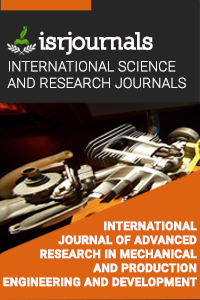experimental studies on ignition delay time for hydrogen – oxygen mixtures at high concentrations
Fathima Niloopher,Aldin Justin
Published in International Journal of Advanced Research in Mechanical and Production Engineering and Development
ISSN: 2320-7256 Impact Factor:1.398 Volume:1 Issue:3 Year: 08 May,2014 Pages:126-133

Abstract
This study addresses the ignition delay time for hydrogen-oxygen mixtures at high concentrations at the sudden rise in pressure. Using a shock tube facility, measurements on ignition delay times of hydrogen-oxygen mixtures diluted with argon (20-30%) were conducted. The experiments have been carried out under normal shock wave conditions at temperatures of 1000-1300 K, pressure of 0.450barfor rich mixtures as well as lean mixtures
Kewords
Ignition delay time, Hydrogen-Oxygen, Shock tube
Reference
[1]. Roger R. Craig, A shock tube study of the ignition delay of hydrogen-air mixtures near the second explosion limit, technical report AFAPL-TR-66-74, 1966. 0 20 40 60 80 0.75 0.8 0.85 0.9 τ, μs 1000/T , K-1 Ignition delay time vs Temperature for rich mixture Ignition delay time vs Temperature for rich mixture [2]. Chenglong Tang, Xingjia Man, Liangjie Wei, Lun Pan, Zuohua Huang, Further study on the ignition delay times of propane-hydrogen-oxygen-argon mixtures: Effect of equivalence ratio, 2013 [3]. R. Blumenthal, K. Fieweger, K.H. Komp, G. Adomeit, B.E. Gelfand, in: Proc of the 20th Int. Symposium on Shock Waves, 1995, pp. 935-940 [4]. E.L. Petersen, D.M. Kalitan, A. Barrett, et al., Combust. Flame 149 (2007) 244-247 [5]. B.L. Wang, H. Oliver, H. Groing, Combust. Flame 133 (2003) 93-106 [6]. V.A. Pavlov, O.P. Shatalov, Measuring the ignition delay time for hydrogen-oxygen mixtures behind the front of an incident shock wave, 2009. [7]. Javier Urzay, Nicolas Kseib, David F. Davidson, Gianlucalaccarino, Ronald K. Hanson, Uncertainty-quantification analysis of the effects of residual impurities on hydrogen-oxygen ignition in shock tubes, 2013[8]. Harry J. Davis, Herbert D. Curchack, Shock tube techniques and instrumentation, 1969. [9]. G.A. Pang, D.F. Davidson, R.K. Hanson, Experimental study and modeling of shock tube ignition delay times for hydrogen-oxygen-argon mixtures at low temperatures, 2009. [10]. N. Lamoureux, C.E. Paillard, V. Vaslier, Low hydrocarbon mixtures ignition delay times investigation behind reflected shock waves, 2001. [11]. V.V. Martynenko, O.G. Penyaz’kov, K.A. Rago tner, S.I. Shabunya, High temperature ignition of hydrogen and air at high pressures downstram of the reflected shock wave, 2004. [12]. M. Nagaboopathy, GopalkrishnaHegde, K.P.J. Reddy, C. Vijayanand, Mukesh Agarwal, D.S.S. Hembram, D. Bilehal, E. Arunan, Ignition delay studies on hydrocarbon fuel with and without additives. [13]. Raymond Brun, Shock tubes and shock tunnels: Design and experiments.

